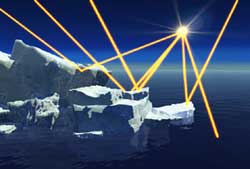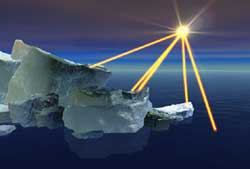27 July 2010
WASHINGTON—The quickest, best way to slow the rapid melting of Arctic sea ice is to reduce soot emissions from the burning of fossil fuel, wood and dung, according to a new study.

 Conceptual animations showing how polar ice reflects light from the sun. As this ice begins to melt, less sunlight gets reflected into space. It is instead absorbed into the oceans and land, raising the overall temperature, and fueling further melting. Darker, soot-covered ice reflects less light as well, part of the warming effect (no audio). Click on either image to view animation. Credit: NASA
Conceptual animations showing how polar ice reflects light from the sun. As this ice begins to melt, less sunlight gets reflected into space. It is instead absorbed into the oceans and land, raising the overall temperature, and fueling further melting. Darker, soot-covered ice reflects less light as well, part of the warming effect (no audio). Click on either image to view animation. Credit: NASA
The study shows that soot is second only to carbon dioxide in contributing to global warming. But, climate models to date have mischaracterized the effects of soot in the atmosphere, said its author Mark Z. Jacobson of Stanford University in Stanford, California. Because of that, soot’s contribution to global warming has been ignored completely in national and international global warming policy legislation, he said.
“Controlling soot may be the only method of significantly slowing Arctic warming within the next two decades,” said Jacobson, director of Stanford’s Atmosphere/Energy Program. “We have to start taking its effects into account in planning our mitigation efforts and the sooner we start making changes, the better.”
The study will be published this week in Journal of Geophysical Research (Atmospheres). Jacobson used a computer model of global climate, air pollution and weather that he developed over the last 20 years and updated to include additional atmospheric processes to analyze how soot can heat clouds, snow and ice.
Soot — black and brown particles that absorb solar radiation — comes from two types of sources: fossil fuels such as diesel, coal, gasoline, jet fuel; and solid biofuels such as wood, manure, dung, and other solid biomass used for home heating and cooking around the world.
Jacobson found that the combination of the two types of soot is the second-leading cause of global warming after carbon dioxide. That ranks the effects of soot ahead of methane, an important greenhouse gas. He also found that soot emissions kill over 1.5 million people prematurely worldwide each year, and afflicts millions more with respiratory illness, cardiovascular disease, and asthma, mostly in the developing world where biofuels are used for home heating and cooking.
Jacobson found that eliminating soot produced by the burning of fossil fuel and solid biofuel could reduce warming above parts of the Arctic Circle in the next fifteen years by up to 1.7 degrees Celsius (3 degrees Fahrenheit). For perspective, net warming in the Arctic has been at least 2.5 degrees Celsius (4.5 degrees Fahrenheit) over the last century and is expected to warm significantly more in the future if nothing is done.
Soot lingers in the atmosphere for only a few weeks before being washed out, so a reduction in soot output would start slowing the pace of global warming almost immediately. Greenhouse gases, in contrast, typically persist in the atmosphere for decades — some up to a century or more — creating a considerable time lag between when emissions are cut and when the results become apparent.
The most immediate, effective and low-cost way to reduce soot emissions is to put particle traps on vehicles, diesel trucks, buses, and construction equipment. Particle traps filter out soot particles from exhaust fumes. Soot could be further reduced by converting vehicles to run on clean, renewable electric power.
Jacobson found that although fossil fuel soot contributed more to global warming, biofuel-derived soot caused about eight times the number of deaths. Providing electricity to rural developing areas, thereby reducing usage of solid biofuels for home heating and cooking, would have major health benefits, he said. Soot from fossil fuels contains more black carbon than soot produced by burning biofuels, which is why there is a difference in warming impact.
Black carbon is highly efficient at absorbing solar radiation in the atmosphere, just like a black shirt on a sunny day. Black carbon converts sunlight to heat and radiates it back to the air around it. This is different from greenhouse gases, which primarily trap heat that rises from the Earth’s surface. Black carbon can also absorb light reflecting from the surface, which helps make it such a potent warming agent.
Black carbon has an especially potent warming effect over the Arctic. When black carbon is present in the air over snow or ice, sunlight can hit the black carbon on its way towards Earth, and also hit it as light reflects off the ice and heads back towards space. Black carbon also lands on the snow, darkening the surface and enhancing melting.
“There is a big concern that if the Arctic melts, it will be a tipping point for the Earth’s climate because the reflective sea ice will be replaced by a much darker, heat absorbing, ocean below,” said Jacobson. “Once the sea ice is gone, it is really hard to regenerate because there is not an efficient mechanism to cool the ocean down in the short term.”
Jacobson is a senior fellow at the Woods Institute for the Environment. This work was supported by grants from the U.S. Environmental Protection Agency, NASA, the NASA high-end computing program, and the National Science Foundation.
Joint Release American Geophysical Union Stanford University
AGU Contact:
Kathleen O’Neil, +1 (202) 777-7524, [email protected]
Stanford Contact:
Louis Bergeron, Stanford News Service, +1 (650) 725-1944, [email protected]
As of the date of this press release, the paper by Jacobson is still “in press” (i.e. not yet published). Journalists and public information officers (PIOs) of educational and scientific institutions who have registered with AGU candownload a PDF copy of this paper in press.
Or, you may order a copy of the paper by emailing your request to Kathleen O’Neil at [email protected]. Please provide your name, the name of your publication, and your phone number.
Neither the paper nor this press release are under embargo.
“Short-term effects of Controlling Fossil-Fuel Soot, Biofuel Soot and Gases, and Methane on Climate, Arctic Ice, and Air Pollution Health”
Mark Z. Jacobson, Dept. of Civil and Environmental Engineering, Stanford University, Stanford, CA, USA.
Mark Jacobson: (650) 723-6836, [email protected]